Mosco, Valerio Paolo Naked Architecture Read Online

Russian architecture follows a tradition whose roots lie in early Russian wooden architecture (inclusive of diverse ethnic elements) and in the architecture of Kievan Rus' with its centers in Veliky Novgorod and Kiev.[ii] From the Rus' era, the Byzantine Empire and Islamic architecture influenced the architecture and culture of Russia.[3] [iv] In other phases of Russian history the compages developed independently and was characterized past national and local features.[5] After the Mongol invasion of Rus, Russian architectural history continued in the principalities of Vladimir-Suzdal, Novgorod, and the succeeding states of the Tsardom of Russia. The great churches of Kievan Rus', built after the adoption of Christianity in 988, were the first examples of awe-inspiring architecture in the East Slavic region. Early Eastern Orthodox churches were mainly built from wood, with their simplest grade known every bit a prison cell church. Cathedrals ofttimes featured many small domes, which has led some art historians to infer how the pagan Slavic temples may have appeared.
Saint Sophia Cathedral in Novgorod (1044–52), on the other hand, expressed a new style which exerted a strong influence on Russian church compages. Its austere thick walls, small-scale, narrow windows accept much in common with the Romanesque architecture of Western Europe. The shape of the onion domes are a distinct feature of Russian architecture.[6] Further departures from the Byzantine model are axiomatic in succeeding Novgorod cathedrals: St Nicholas' (1113), St Anthony'southward (1117–nineteen), and St George's (1119). The secular compages of Kievan Rus' has barely survived. Until the 20th century just the Golden Gates of Vladimir, despite much 18th-century restoration, could exist regarded equally an accurate monument of the pre-Mongol period. During the 1940s, archaeologist Nikolai Voronin discovered the well-preserved remains of Andrei Bogolyubsky's palace in Bogolyubovo (dating from 1158 to 1165).
The city of Novgorod preserved its architecture during the Mongol invasion. The showtime churches were commissioned past the princes; nevertheless, after the 13th century merchants, guilds and communities began to commission cathedrals. The citizens of 13th-century Novgorod were noted for their shrewdness, diligence and prosperity, expanding from the Baltic to the White Sea. The architecture in Novgorod did not begin to flourish until the plough of the 12th century. The Novgorod Sophia cathedral was modeled after the original Saint Sophia Cathedral in Kiev; it is similar in appearance only smaller, narrower and (in a development of North Russian architecture) onion-shaped domes replace cupolas. Structure was supervised by workmen from Kiev, who also imported bricks. The primary building materials were fieldstone and undressed limestone blocks. It is said that the interiors were painted in frescoes, which have now vanished. The doors were made of statuary.
The katholikon of Yuriev Monastery was commissioned in 1119 by Prince Vsevolod of Pskov. The architect was known as Master Peter, one of the few architects who have been recorded at this time in Russia. The exterior is characterized by narrow windows and double-recessed niches, which proceed in a rhythm beyond the façade; the interior walls reach a height of 20 metres (66 ft). Its pillars are closely spaced, emphasizing the height of the vaulted ceilings. The interior was covered in frescoes from the prince'south workshops, including some of the rarest Russian paintings of the time.
The Church of the Transfiguration of the Savior was a memorial to Ilya Muromets. During the Mongol invasion, Ilya was reputed to accept saved the metropolis; the church was built in his honour on Elijah Street in 1374. During this time the city-state of Novgorod established a split district for the princes, subdividing the city into a series of streets where the church still stands. The church building windows are more than detailed, the niches deeper and the dome (seen in larger cathedrals) is augmented by a pitched roof.
Another church closely resembling the Church of the Transfiguration is the Church of Saints Peter and Paul in Kozhevniki. Information technology was synthetic in 1406, and the primary difference is in edifice material. The detail is focused on the west and south facades. New ornamental motifs in the brick appear at this fourth dimension. Brick was also used for the pilasters which delineate the façade. It was originally plastered, only underwent restoration later on information technology was damaged during Globe War Two. Its apse points towards the river, which provides a welcome sight for ships approaching from the Baltic. The shingled roof resembles the bochka roofs popular at the fourth dimension. The walls were built from local quarrystone, which contrasted with the ruby-red bricks. The footing plan of the church is almost foursquare with 4 pillars, one apse and one dome.
Pre-Christian compages (before 988) [edit]
Russian compages is a mix of Eastern Roman and Infidel architecture. Some characteristics taken from the Slavic pagan temples are the exterior galleries and the plurality of towers.
Between the 6th and the 8th century, the Slavs built fortresses, named grods, which were tightly constructed wooden mechanisms of separation.[7]
Kievan Rus Christian period (988–1230) [edit]
-

-

-

-

-

-

-

-

-

Remains of the Bogolyubov castle (left) and The Temple of the Nascency of the Blessed Virgin (right) (1158)
-
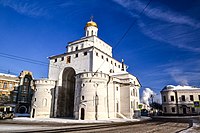
-

-
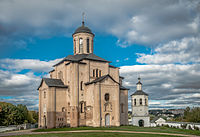
St. Michael the Archangel Church in Smolensk (1180–1197)
-
-

-

-

Early Muscovite period (1230–1530) [edit]
The Mongols looted the state then thoroughly that even capitals (such every bit Moscow or Tver) could not afford new rock churches for more one-half a century. Novgorod and Pskov escaped the Mongol yoke, however, and evolved into successful commercial republics; dozens of medieval churches (from the twelfth century and after) have been preserved in these towns. The churches of Novgorod (such as the Church of the Transfiguration on Ilyina Street, built in 1374), are steep-roofed and roughly carved; some contain magnificent medieval frescoes. The tiny and picturesque churches of Pskov characteristic many novel elements: corbel arches, church porches, exterior galleries and bell towers. All these features were introduced by Pskov masons to Muscovy, where they constructed numerous buildings during the 15th century (including the Church of the Degradation of the Robe of the Moscow Kremlin (1484) and the Church of the Holy Spirit of the Trinity Lavra of St. Sergius, congenital in 1476).
The 14th-century churches of Muscovy are few, and their ages are disputed. Typical monuments – found in Nikolskoe (almost Ruza, perhaps from the 1320s) and Kolomna (possibly from the 2nd decade of the 14th century) – are atomic single-domed fortified churches, built of roughly hewn ("wild") rock and capable of withstanding brief sieges. Past the construction of the Supposition Cathedral in Zvenigorod (peradventure in 1399), Muscovite masons regained the mastery of pre-Mongol builders and solved some of the construction problems which had puzzled their predecessors. Signature monuments of early Muscovite architecture are institute in the Trinity Lavra of St. Sergius (1423), Savvin Monastery of Zvenigorod (possibly 1405) and St. Andronik Monastery in Moscow (1427).
By the end of the 15th century, Muscovy was then powerful a state that its prestige required magnificent, multi-domed buildings on a par with the pre-Mongol cathedrals of Novgorod and Vladimir. They reproduced ancient Vladimir structures in three large cathedrals in the Moscow Kremlin, and decorated them with Italian Renaissance motifs. These ambitious Kremlin cathedrals (amidst them the Dormition and Archangel Cathedrals) were imitated throughout Russia during the 16th century, with new edifices tending to be larger and more ornate than their predecessors (for example, the Hodegetria Cathedral of Novodevichy Convent from the 1520s).
Autonomously from churches, many other structures date from Ivan III'south reign. These include fortifications (Kitai-gorod, the Kremlin (its current towers were built subsequently), Ivangorod), towers (Ivan the Great Bell Tower) and palaces (the Palace of Facets and the Uglich Palace). The number and diverseness of extant buildings may exist attributed to the fact that Italian architects persuaded Muscovites to abandon prestigious, expensive and unwieldy limestone for much cheaper and lighter brick as the principal construction material.
-

-
-

-
Episcopal palace in Suzdal (15th century)
-

-
-
-

-

-

-

Eye Muscovite period (1530–1630) [edit]
In the 16th century, the key evolution was the introduction of the tented roof in brick compages. Tent-like roof construction is idea to have originated in northern Russia,[ citation needed ] since it prevented snow from piling up on wooden buildings during long winters. In wooden churches (even modern ones), this type of roof has been very popular. The first tent-similar brick church is the Ascension church in Kolomenskoe (1531), designed to commemorate the birth of Ivan the Terrible. Its design gives rising to speculation; information technology is likely that this style (never found in other Orthodox countries) symbolized the ambition of the nascent Russian state and the liberation of Russian art from Byzantine canons subsequently the Fall of Constantinople to the Turks.
Tented churches were popular during the reign of Ivan the Terrible. Two prime examples dating from his reign employ several tents of exotic shapes and colors, arranged in an intricate design: the Church of St John the Baptist in Kolomenskoye (1547) and Saint Basil's Cathedral on Carmine Foursquare (1561). The latter church unites nine tented roofs in a hitting circular composition.
-

Reconstructed example of Russian wooden architecture in Moscow which was typical for Russian architecture during 16th and 17th centuries. Typical architectural elements of Russian wooden architecture were at those times the curved large cube roof and its patterns.[8] [9]
-

-

-

-

Late Muscovite catamenia (1630–1712) [edit]
After the Time of Troubles the church and state were bankrupt, unable to finance any structure works; an initiative was taken by rich merchants in Yaroslavl, on the Volga. During the 17th century, they built many large cathedral-type churches with five onion-like domes, surrounding them with tents of bong towers and aisles. At first the churches' composition was sharply asymmetrical, with different parts balancing each other on the "scale-axle" principle (east.thousand., the Church building of Elijah the Prophet, 1647–l). Subsequently, the Yaroslavl churches were strictly symmetrical, with domes taller than the building itself, and handsomely decorated with polychrome tiles (due east.g., the Church of John the Chrysostom on the Volga, 1649–54). A zenith of Volga compages was reached in the Church of St John the Baptist (built 1671–87) – the largest in Yaroslavl, with 15 domes and more than than 500 frescoes. The brick outside of the church, from the cupolas down to the tall porches, was elaborately carved and decorated with tiles.
The 17th-century Moscow churches are also profusely decorated, only they are much smaller in size. Before in the century, the Muscovites still favoured tent-like constructions. The chief object of their admiration was the "Miraculous" Assumption Church in Uglich (1627): it had three graceful tents in a row, reminiscent of three burning candles. This composition was extravagantly employed in the Hodegetria Church of Vyazma (1638) and the Nativity Church at Putinki, Moscow (1652). Assuming that such constructions ran counter to the traditional Byzantine type, the Patriarch Nikon declared them un-canonical. He encouraged building elaborate ecclesiastical residences (such every bit the Rostov Kremlin on the Nero Lake, which featured v tall churches, many towers, palaces, and chambers). Nikon designed his new residence at the New Jerusalem Monastery, which was dominated by a rotunda-like cathedral, the showtime of its type in Russia.
Since the tents were banned, the Muscovite architects had to replace them with successive rows of corbel arches (kokoshniks), and this decorative element was to become a hallmark of 17th-century Moscow flamboyant style. An early on instance of the flamboyant style is the Kazan Cathedral on Ruddy Square (1633–36). By the finish of the century, more than than 100 churches in the fiery style were erected in Moscow, and possibly every bit many again in the neighbouring region. Amongst the more splendid examples are the Moscow churches of the Holy Trinity at Nikitniki (1653), St Nicholas at Khamovniki (1682), and Holy Trinity at Ostankino (1692). Probably the about representative flamboyant-style structure was the Church of St Nicholas (the "Grand Cross") in the Kitai-gorod, brutally destroyed at Stalin's behest.
As Russian architecture degenerated into the purely decorative, it was also influenced past the Polish and Ukrainian Baroque. The first Baroque churches were small chapels built on the Naryshkin family unit's estates near Moscow, so the name of Naryshkin Baroque is often applied to this fashion. Some of these churches are belfry-similar, with cubic and octagonal floors placed atop each other (the Saviour Church building at Ubory, 1697); others have a ladder-like composition, with a bell belfry rising above the church itself (the Intercession Church at Fili, 1695). The Bizarre and flamboyant-way decoration is often so profuse that the church seems to be the work of a jeweller rather than a mason (due east.grand., the Trinity Church at Lykovo, 1696). Maybe the most delightful example of the Naryshkin Baroque was the multi-domed Supposition Church on the Pokrovka Street in Moscow (built 1696–99, demolished 1929). Its architect was as well responsible for the "blood-red and white" reconstruction of several Moscow monastic structures, notably the Novodevichy Convent and the Donskoy Monastery.
The Baroque way quickly spread throughout Russian federation, gradually replacing more traditional and approved architecture. The Stroganov merchants sponsored construction of majestic Bizarre structures in Nizhny Novgorod (the Nativity Church building, 1703) and in the remote Solvychegodsk (the Presentation Cathedral, 1693). During the kickoff decades of the 18th century, some remarkable Baroque cathedrals were built in such eastern towns every bit Kazan, Solikamsk, Verkhoturye, Tobolsk and Irkutsk. Also interesting are the traditional wooden churches by carpenters of the Russian North. Working without hammer and nails, they constructed such baroque structures every bit the 24-domed Intercession Church building at Vytegra (1708, burnt downward 1963) and the 22-domed Transfiguration Church at Kizhi (1714).
-

-

-
-

-
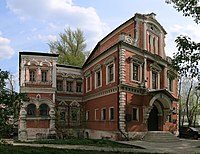
-

-

Palace of the wealthy merchant family unit Pogankin in Pskov (1671–1679)
-

-

-

Metropolitan Palace in Yaroslavl (1680th–1690th)
-
Znamenskaya Church building (1690–1704)
-

-

Imperial Russian federation (1712–1917) [edit]
In 1712, Peter I of Russian federation moved the majuscule from Moscow to St Petersburg, which he planned to design in the style commonly chosen Petrine Baroque. Its major monuments include the Peter and Paul Cathedral and Menshikov Palace. During the reign of Empress Anna and Elizaveta Petrovna, Russian architecture was dominated past the luxurious Baroque fashion of Bartolomeo Rastrelli; Rastrelli'south signature buildings include the Wintertime Palace, the Catherine Palace and the Smolny Cathedral. Other distinctive monuments of the Elizabethan Baroque are the bell tower of the Troitse-Sergiyeva Lavra and the Ruddy Gate.
Catherine the Great dismissed Rastrelli and patronized neoclassical architects invited from Scotland and Italia. Some representative buildings from her reign are the Alexander Palace (by Giacomo Quarenghi) and the Trinity Cathedral of the Alexander Nevsky Lavra (by Ivan Starov). During Catherine's reign, the Russian Gothic Revival style was developed by Vasily Bazhenov and Matvei Kazakov in Moscow. Alexander I of Russia favoured the Empire style, which became de facto the only style of his menstruation, evidenced by the Kazan Cathedral, the Admiralty building, the Bolshoi Theatre, St Isaac'southward Cathedral, and the Narva Triumphal Gates in Saint Petersburg. The Empire style's influence was even greater in Moscow, which had to rebuild thousands of houses destroyed by the burn down of 1812.
In the 1830s Nicholas I eased regulation in compages, opening the merchandise to several incarnations of early on eclecticism. Konstantin Ton's pseudo-Russian designs became the preferred choice in church construction (Cathedral of Christ the Saviour, 1832–1883), while his public buildings followed Renaissance tradition, exemplified in the Smashing Kremlin Palace (1838–49) and the Kremlin Armoury (1844–1851). The subsequent reigns of Alexander II and Alexander 3 promoted a Russian Byzantine Revival in church compages, while civil construction followed the same diverseness of eclecticism common in all European countries; this featured ever-growing national revival trends, vernacular and imaginary.
Between 1895 and 1905 architecture was briefly dominated by Russian Art Nouveau, nearly active in Moscow (Lev Kekushev, Fyodor Schechtel and William Walcot). While information technology remained a popular choice until the outbreak of Globe War I, in 1905–1914 information technology gave way to the Russian neoclassical revival – merging the Empire style and Palladian tradition with gimmicky structure technology.
-

-

-

-

-

-

-

-

-

-

-

-

-

-
-

GUM department store (1890–1893)
-

-

-

Mail-Revolution (1917–1932) [edit]
In the offset year of Soviet dominion all architects refusing to emigrate (and the new generation) denounced whatsoever classical heritage in their work and began to propagate formalism, the about influential of all Revivalist themes. Great plans were drawn for large, technically avant-garde cities. The most aggressive of all was the Monument to the Third International, planned in 1919 by Vladimir Tatlin (1885–1953), а 400-meter spiral, wound around a tilted central axis with rotating glass chambers. Impossible in existent life, the Tatlin Belfry inspired a generation of Constructivist architects in Russia and abroad. The Shukhov Belfry, ascension 160 metres (520 ft) above Moscow, was completed in 1922. According to the initial plans, the hyperboloid tower by Vladimir Shukhov with a height of 350 metres (1,150 ft) had an estimated mass of ii,200 tonnes (2,200,000 kg), while the Eiffel Belfry in Paris (with a height of 350 metres (one,150 ft)) weighs vii,300 tonnes (7,300,000 kg).
Residents of apartment buildings were sealed, they were hooked past new tenants. The and then-called kommunalka became the most common blazon of adaptation for the residents of large cities. In each communal apartment one room belonged to one family, while bathroom, toilet and kitchen were shared. Such a scheme was widespread until the mid-1950s, and in some cities there are more communal apartments. At the same time with the 1930s for senior people began to build houses with separate bedchamber apartments, where one family unit was given the whole flat. An case of such a house called House on the Beach (Dom na naberezhnoi) in Moscow, built in 1927–1931, respectively.
An important priority during the post-revolutionary catamenia was the mass reconstruction of cities. In 1918 Alexey Shchusev (1873–1949) and Ivan Zholtovsky founded the Mossovet Architectural Workshop, where the complex planning of Moscow's reconstruction as a new Soviet capital took place. The workshop employed young architects who later emerged as advanced leaders. At the same time architectural education, concentrated in the Vkhutemas, was divided betwixt revivalists and modernists.
In 1919, Petrograd saw a similar planning and educational setup, headed by experienced revivalist Ivan Fomin (1872–1936). Other cities followed suit and the results of the work carried out at that place were to make dramatic changes in traditional Russian city layout. The first large-scale development templates (generalny program) were fatigued there. The city was planned equally a serial of new wide avenues, massive public structures and the improvement of workers' housing with heat and plumbing. The first apartment building of this menses was completed in 1923, followed by a surge of public-housing construction in 1925–1929.
In Petrograd from 1917 to 1919 the start example of the new style was built on the Field of Mars – a monument, "Strugglers of the Revolution", designed past Lev Rudnev (1886–1956). This circuitous consisted of a series of simple, expressive granite monoliths and became the focal point for farther development in Soviet sculptural and memorial architecture. The most famous structure of this time, however, was Lenin's Mausoleum by Alexey Shchusev. Originally it was a temporary wooden structure, topped by a pyramid, with two wings (for entry and exit). In 1930 information technology was replaced with the present building, built of stone. The combination of dark red and black labradorite enhanced its slender, precise construction.
The rapid development of technological processes and materials as well influenced constructivist elements in structure design. During the erection of the Volkhov Hydroelectric Station (1918–26, architects O.Munts and V.Pokrovsky), the traditional outline on the window arches is still used (despite concrete being used in construction). The Dnieper Hydroelectric Station (1927–32), built by a collective of architects headed by Viktor Vesnin (1882–1950), has an innovative pattern featuring a curved dam with a rhythmic design of foundations. Creative unions played a large role in the architectural life of 1920s Russia. One of these was the Association of New Architects (ASNOVA), formed in 1923, which promoted the idea of synthesising architecture and other creative arts to give buildings an almost sculptural feeling. These buildings were to serve as visual points for the orientation of a human in space. Members of ASNOVA as well designed Moscow's first skyscrapers, none of which were realised at the time (1923–1926).
Another innovation from post-revolutionary Russian federation was a new blazon of public building: the Workers' Club and the Palace of Civilisation. These became a new focus for architects, who used the visual expression of large elements combined with industrial motifs. The most famous of these was the Zuev Workers' Gild (1927–29) in Moscow by Ilya Golosov (1883–1945), whose composition relied on the dynamic contrast of elementary shapes, planes, consummate walls and glazed surfaces.
Symbolic expression in structure was a feature in works designed by Konstantin Melnikov (1890–1974), notably the Rusakov Workers' Club (1927–1929) in Moscow. Visually, the building resembles part of a gear; each of the three cantilevered physical "teeth" is a balcony of the main auditorium, which could be used individually or combined into a big theatre hall. The sharpness of its composition and the "transition" of internal space (called by Melnikov a "tensed muscle") fabricated it one of the most important examples of Soviet architecture.
Postwar Soviet Union [edit]
Stalinist architecture put a premium on conservative monumentalism. During the 1930s at that place was rapid urbanisation equally a upshot of Stalin's policies, and there was an international competition to build the Palace of the Soviets in Moscow at that time. After 1945, the focus was on both rebuilding structures destroyed in World War Two and erecting new ones: seven high-rise buildings were congenital at symbolic points in the Moscow surface area. The construction of Moscow University (1948–1953), by Lev Rudnev and associates, is specially notable for its use of space. Another instance is the Exhibition Centre in Moscow, built for the second All-Spousal relationship Agricultural Exhibition (VSKhV) in 1954. This featured a serial of pavilions, each decorated in representative way. Other well-known examples are the stations of the Moscow and Petrograd Metros congenital during the 1940s and 1950s, famous for their extravagant blueprint and vivid decoration. In general, Stalinist compages changed the appearance of many post-war cities; much survives to this day in fundamental avenues and public buildings.
Following Stalin's death in 1953, social and political changes rocked the country; structure priorities and architecture were likewise affected. In 1955 Nikita Khrushchev, faced with the ho-hum pace of housing structure, called for drastic measures to accelerate the process. This involved developing new mass-production engineering and removing "decorative extras" from buildings. On special plants that were built in every major city had launched production of special concrete blocks ready openings for doors and windows of which were built houses. These prefabricated blocks were brought from the factory ready-made and installed on the steel frame of a firm. Houses built in this mode were chosen block houses. All projects such houses have become standardized and take been summarized in several serial (for example II-32 series), which were built houses. Projects for a buyout built schools, kindergartens and hospitals were also typical. This put an constructive end to Stalinist architecture; withal, the transition was slow. Most projects in the planning state or under construction by 1955 were directly affected; the result, at times, was entire areas becoming esthetically asymmetrical. A well-known example occurred in the postwar reconstruction of the Ukrainian upper-case letter, Kiev (now Kyiv), in which the planned Kreschatik artery and its central square (Ploschad Kalinina) were to course a single rich space enclosed by Stalinist compages. As the buildings enclosing the latter were in completion, the architects were forced to change their plans and the area was left unfinished until the early 1980s. In particular Hotel Ukrayina, which was to crown the foursquare with a look like to i of Moscow'due south "Seven Sisters", was left every bit a solid shape without a height spire or any rich external ornament.
Nevertheless, as the buildings became more square and simple they brought with them a new style fueled past the Infinite Historic period: functionality. The Country Kremlin Palace is an hommage to an earlier attempt to span speedily changing styles dictated by the state. The Ostankino Tower, by Nikolai Nikitin, symbolizes technological advances and the time to come. In improver to simpler buildings, the 1960s are remembered for massive housing plans. A typical projection was developed using physical panels to make a simple, 5-story firm. These Pyatietazhki became the ascendant housing construction. Although rapidly built, their quality was poor compared with before housing; their monotonous advent contributed to the grey and dull stereotype feature of socialist cities.
As the 1970s began, Leonid Brezhnev immune architects more liberty; soon, housing of varied design was congenital. Blocks of flats were taller and more decorated; large mosaics on their sides became a feature. In nigh all cases, these were built non as standalone construction but as part of large estates (French: housing massif) which presently became a key characteristic of socialist cities. In contrast to the houses congenital in the 1950s–1960s, which had up to 5 floors, new residential buildings were college and could have up to nine or more floors, although the firm with fewer floors continued to be built. Each complex includes an all-encompassing expanse with a chiliad for walks, a playground with swings, a sandbox for the games and sites for parking vehicles, which are often supplemented by garages for cars, lined upward separately from the residential buildings. This principle remains today. Public buildings were congenital with a diversity of themes. Some (like the White House of Russia) made direct connections to earlier 1950s architecture, with a white marble-faced outside and big bas-reliefs on the wings.
-

-
-

-
-
Guest House On Kosmodamianskaya Naberezhnaya
-

-

-

-

-

-

-

-
-
-

-

-

Modern Russia [edit]
Equally the Soviet Spousal relationship barbarous autonomously, many of its projects were put on hold and some cancelled altogether. Nonetheless, for the starting time time there was no longer any control over what theme a building should take or how high it should be. As a event, with generally improving financial conditions architecture grew at a high rate. For the first time modern methods of skyscraper construction were implemented, this resulted in an ambitious Moscow International Business Eye. In other cases, architects returned to successful designs of Stalinist architecture, which resulted in buildings like the Triumph Palace in Moscow. New Classical Architecture is also actualization more consistently throughout modern Russian federation, with a large circuitous being proposed for Petrograd.[ten]
-

-

-

Petrograd Plaza
-

-

-

Sokolinaya Gora
-

-

-

-

-

-

-

-

-
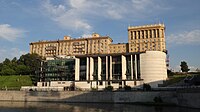
-

-

Meet also [edit]
- Russian Revival architecture
- Listing of tallest buildings in Russian federation
- Listing of Russian architects
- Latvian Academy of Sciences
- Alexander Nevsky Cathedral, Warsaw
- Warsaw Palace of Culture and Science
- Russian Church building, Sofia
References [edit]
- ^ "A History Of Russian Architecture | RWJoninery, Bespoke Joinery". Bespoke Joinery - Manchester & Northward West. 2018-07-27. Retrieved 2019-04-18 .
- ^ Wood, Christopher. "Early on Russian Architecture 989-1703" (PDF).
- ^ Voyce, Arthur (1957). "National Elements in Russian Architecture". Journal of the Lodge of Architectural Historians. xvi (2): vi–sixteen. doi:ten.2307/987741. ISSN 0037-9808. JSTOR 987741.
- ^ "The Origins of Modernism in Russian Architecture". publishing.cdlib.org . Retrieved 2021-eleven-23 .
- ^ Voyce, Arthur (1957). "National Elements in Russian Architecture". Periodical of the Order of Architectural Historians. sixteen (2): 6–16. doi:10.2307/987741. ISSN 0037-9808. JSTOR 987741.
- ^ Lidov, Alexei. "The Awning over the Holy Sepulchre. On the Origin of Onion-Shaped Domes". The Canopy over the Holy Sepulchre. On the Origin of Onion-Shaped Domes /Jerusalem in Russian Civilisation, ed. A. Batalov and A.Lidov. New York – Athens, 2005, Pp.171-180.
- ^ Rem Koolhaas, James Westcott, Stephan Petermann (2017). Elements of Architecture. Taschen. p. 102. ISBN978-3-8365-5614-9.
{{cite volume}}: CS1 maint: multiple names: authors listing (link) - ^ "Русское деревянное зодчество. Терема". wowavostok.livejournal.com . Retrieved 2019-08-25 .
- ^ Partina, A. S. (Alla Semenovna) (1994). Arkhitekturnye terminy : illi︠u︡strirovannyĭ slovarʹ. Moskva: Stroĭizdat. ISBN5274020720. OCLC 37966587.
- ^ "Russia'due south Classical Futurity". andrewcusack.com. thirty September 2014.
- "Compages: Kievan Rus and Russian federation" in Encyclopædia Britannica (Macropedia) vol. xiii, 15th ed., 2003, p. 921.
- William Craft Brumfield, Landmarks of Russian Architecture: A Photographic Survey. Amsterdam: Gordon and Breach, 1997
- John Fleming, Hugh Accolade, Nikolaus Pevsner. "Russian Architecture" in The Penguin Dictionary of Compages and Mural Architecture, 5th ed., [1966] 1998, pp. 493–498, London: Penguin. ISBN 0-670-88017-5.
- Russian art and architecture, in The Columbia Encyclopedia, Sixth Edition, 2001–05.
- Encyclopædia BritannicaWestern architecture retrieved 12 August 2005
- Near.com feature on Russian architecture retrieved 12 August 2005
- Grove Art Online articles on Russian compages Oxford University Press 2005 retrieved 12 August
- Russian Life July/Baronial 2000 Volume 43 Issue four "Faithful Reproduction" an interview with Russian architecture expert William Brumfield on the rebuilding of Christ the Saviour Cathedral
Farther reading [edit]
- Fletcher, Banister; Cruickshank, Dan, Sir Banister Fletcher'south a History of Architecture, Architectural Printing, 20th edition, 1996 (get-go published 1896)bISBN 0-7506-2267-ix. Cf. Part Ii, Chapter 12.
- William Craft Brumfield, A History of Russian Architecture. Seattle and London: University of Washington Printing, [1993] 2004. ISBN 0-295-98393-0
External links [edit]
- The William C. Brumfield Collection, office of Meeting of Frontiers: Siberia, Alaska, and the American West
- Russian Compages
- (in Russian) Russian photosite of Orthodox architecture
- (in Russian) Russian society of architects
- (in Ukrainian) "Architectural links between Ukraine and Russia" by Igor Grabar
- Russian wooden churches
- [1]
Source: https://en.wikipedia.org/wiki/Russian_architecture









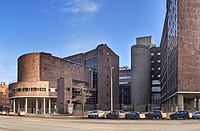



















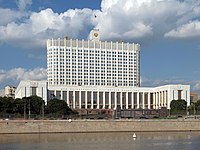
0 Response to "Mosco, Valerio Paolo Naked Architecture Read Online"
Post a Comment